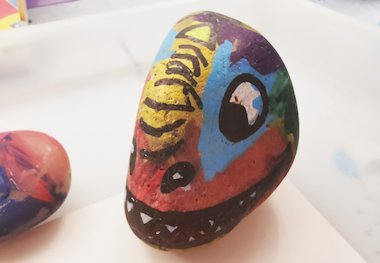Pebbles, eggs and nests
Add to My Folder
It’s often the simplest activities that provide children with the most fun and best learning opportunities, and the hands-on activities here are both low on resources and simple enough to allow children to independently explore materials and ideas while creating and being imaginative.

Activity 1: Painting pebbles
This is a great activity for encouraging imaginative thinking, with children using the naturally occurring shapes and patterns found in nature to inspire their own creations.
EYFS Area of learning > Expressive arts & design > Creating with Materials EYFS Area of learning > Expressive arts & design > Being Imaginative and Expressive EYFS Area of learning > Understanding the world > The Natural World
What you need
- Pebbles — these can be found in a garden or playground, bought from a garden supplier, or bought online. It’s important to point out here that it is actually illegal to bring home pebbles from a beach so unless you have some old ones previously collected, beach pebbles shouldn’t be used.
- White paint, if you wish to create a plain surface for drawing on — acrylic is best.
- Craft pens.
- Googly eyes — optional.
You may wish to source the pebbles from your garden area, turning the hunt into a bit of an activity in itself by looking for bugs while you search. Garden pebbles are good for this activity in that they come in all shapes and sizes, lending themselves to creative thinking — especially as some have holes, unusual markings, patterns and colours, all conjuring up imaginative ideas for creatures they could be turned into.
What to do
Give the pebbles a good wash in a bowl of soapy water, then dry them with an old towel before taking them indoors to paint and colour.
If some of the pebbles are very dark in colour the children could paint them white first, to give a light background for drawing a design. The children may wish to decorate the pebbles in a way that reflects their shape, for example as ladybirds, hedgehogs or eggs, or they can draw a design onto the pebble that doesn’t correspond to its shape at all. It is fun though to have a good look at a pebble’s natural features to see if there are any shapes or patterns that inspire specific designs, for example, a pebble might be shaped like a mouse, or a have mark that looks like a bird’s wing. The children could also add some stick-on googly eyes for a bit of extra fun.
Already a member? Sign in below.
Published 29 March 2022
Reviews
You need to be signed in to place a review.